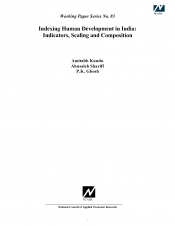Indexing Human Development in India: Indicators, Scaling and Composition
Abusaleh Shariff
Amitabh Kundu
April 2002
The paper analyses methodological issues concerning selection of indicators, making them scale-free and construction of composite indices within the framework of measuring human development. It reviews the existing literature in the area and highlights the key areas of concern from the viewpoint of methodology of aggregation. It discusses the implications of the assumptions underlying different techniques, currently being used in India, in the context of an empirical exercise of constructing an index of human development at state level. It examines the advantages and disadvantages of these techniques and proposes improvements therein for bringing them closer to empirical reality and thereby increasing their acceptability among the planners and policy-makers. The study suggests that exercises at determining the levels of human development at the state or district level by official agencies like the Planning Commission, concerned ministries or an international agency must enjoy large acceptability so that these can be used in policy-making. Agreements must be obtained in terms of choice of indicators, scaling, methodology of composition, etc. Establishing certain degree of uniformity in methodology through deliberations in a committee at the highest level (as was done in case of measuring poverty) will accord credence to the results and help clear the uncertainty and inconclusiveness that characterise the current debate.
Human Development and Data Innovation







